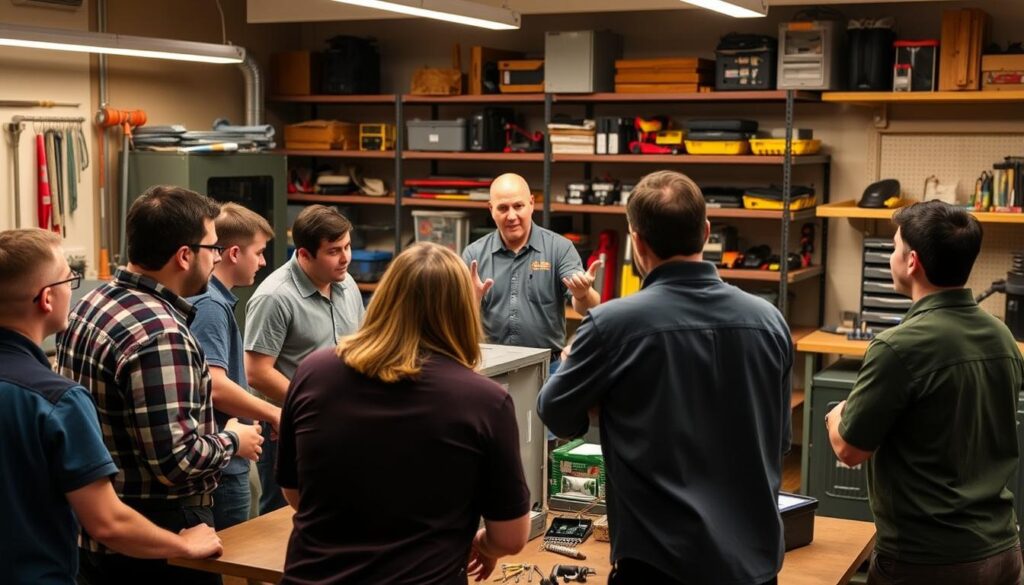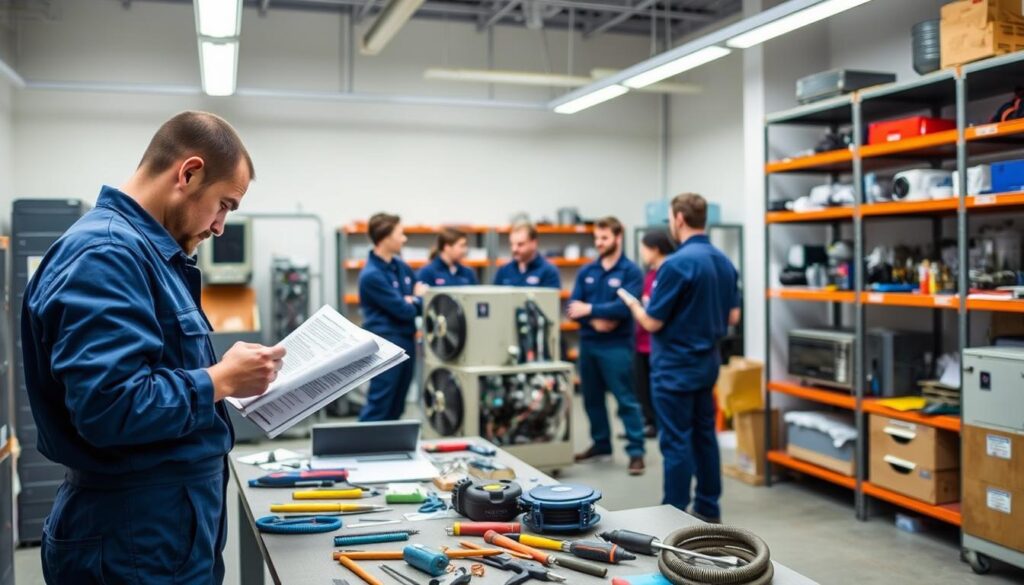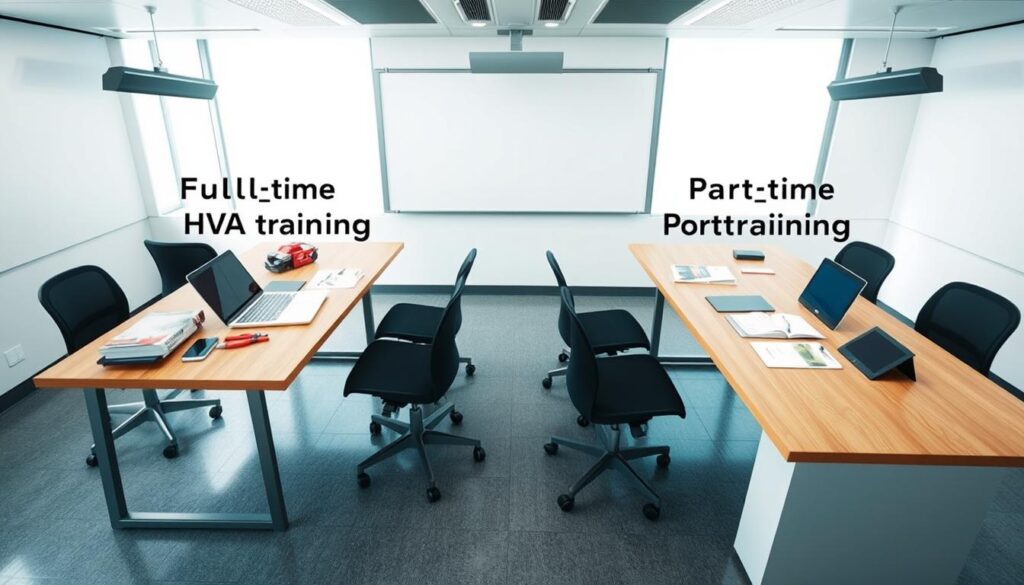Affiliate Disclosure
HVAC Guide Guys is a participant in the Amazon Services LLC Associates Program, an affiliate advertising program designed to provide a means for sites to earn advertising fees by advertising and linking to Amazon.
How Long Is HVAC Trade School? Are you curious about how fast you can start a new career in HVAC? Becoming an HVAC technician might take less time than you think. Training can last from 6 months to 2 years, which is quicker than getting a traditional college degree.

The U.S. Bureau of Labor Statistics shows a great chance for HVAC jobs. They predict a 5% growth in HVAC service technician jobs by 2031. This means lots of job openings for those who choose HVAC training.
How long you spend in HVAC school depends on your goals and life situation. You can pick from quick certificate programs or longer degrees. There’s a path that matches your needs.
Key Takeaways
- HVAC training can be completed in as little as 6 months
- Multiple program options exist, from certificates to associate degrees
- Job market for HVAC technicians continues to grow
- Certifications are key for moving up in your career
- Flexible learning paths fit different schedules
Table of Contents
Overview of HVAC Training Programs and Duration
Choosing the right HVAC training program is key to your career. The length of these programs varies, giving you several paths to become a skilled technician. Knowing these options helps you decide on your professional path.
The time it takes to become an HVAC technician can range from a few months to several years. This depends on the program you choose. Each path has its own benefits for those starting in HVAC.
Traditional Training Paths
Traditional HVAC training has two main paths:
- Community College Programs
- 2-4 years in duration
- Comprehensive theoretical and practical training
- Results in an Associate’s degree
- Apprenticeship Programs
- Typically 4 years long
- Combines classroom instruction with hands-on work experience
- Provides paid on-the-job training
Accelerated Learning Options
For quicker entry into HVAC, accelerated programs are great:
- Certificate Programs: 6-12 months
- Trade School Programs: 7-9 months
- Intensive Technical Training: As short as 8 months
Program Length Variations
The length of your HVAC program depends on several things:
- Study mode (full-time or part-time)
- Program type (certificate, diploma, associate degree)
- Individual learning pace
- Specific school curriculum
Pro tip: Research multiple programs to find the best fit for your career goals and personal schedule.
How Long Is HVAC Trade School: Different Program Types
Exploring HVAC trade school options reveals various program types. These are designed to fit your career goals and learning style. You can choose from short-term certificates to full associate degrees.
HVAC vocational school curriculum includes several key program options:
- Certificate Programs: Short-term training lasting 6-12 months
- Diploma Programs: 12-18 month courses
- Associate Degree Programs: 2-3 year educational tracks
Each program has its own benefits for aspiring HVAC technicians. Certificate programs get you started quickly. Associate degrees offer deeper technical knowledge. The curriculum covers essential areas like:
- Refrigeration systems
- Electrical system fundamentals
- Heating and cooling technologies
- Safety protocols
- Troubleshooting techniques
Your choice depends on your career goals and time. Some finish in 8 months, while others take 2-3 years. Many programs include 135 hours of practical training.
Pro tip: Consider your long-term career goals when selecting an HVAC training program.
Explore Our HVAC Shop
Looking for top-rated HVAC tools, parts, and accessories? Visit our shop and find the perfect solution for your needs.
Visit the ShopFast-Track HVAC Programs: 9-Month Training Options
Are you eager to start your HVAC career? Accelerated training programs are a great way to quickly get into this exciting field. These programs offer a deep dive into HVAC technology in just nine months.
Fast-track HVAC programs are designed to get you ready for work fast. They pack a lot of learning into a short time. This means you can start your HVAC career sooner.
Curriculum Structure
The 9-month program is packed with important learning areas:
- Diagnostic techniques for HVAC systems
- Mechanical and electrical system fundamentals
- Advanced control system training
- Safety protocol implementation
Course Components
Students get a mix of classroom learning and hands-on practice:
- Classroom instruction on HVAC technology
- Laboratory-based equipment training
- Practical installation and maintenance workshops
- Certification exam preparation
Time Management Requirements
Doing well in an accelerated HVAC program takes hard work and good time management. Full-time students spend 30-40 hours a week learning. This includes both classroom and practical training.
| Program Feature | Details |
|---|---|
| Total Training Duration | 9 Months |
| Weekly Time Commitment | 30-40 Hours |
| Potential Annual Salary | $50,000 – $75,000 |
Invest in your future with an accelerated HVAC training program that prepares you for a rewarding technical career in just nine months!
Explore Our HVAC Shop
Looking for top-rated HVAC tools, parts, and accessories? Visit our shop and find the perfect solution for your needs.
Visit the ShopHVAC Apprenticeship Programs: Timeline and Requirements

Exploring HVAC careers means knowing about apprenticeship lengths. HVAC programs usually last 3 to 5 years. They mix classroom learning with real-world experience.
Learning in a structured setting offers many benefits. You can:
- Earn while you learn through paid training opportunities
- Gain hands-on technical skills directly in the field
- Receive mentorship from experienced professionals
- Build a professional network within the HVAC industry
The time you spend in training varies. It depends on state rules and the program. Most apprenticeships need about 2,000 hours of field work and 144 hours of classroom learning each year.
There are key things you need for HVAC apprenticeships:
- High school diploma or equivalent
- Minimum age of 18
- Basic math and reading skills
- Physical fitness for demanding work
Pro tip: Talk to local unions, tech schools, and state boards for specific requirements. Each area has its own rules for HVAC training and certification.
Core Components of HVAC Technical Education
Your HVAC technical education is a journey that mixes theory with practical skills. It’s designed to get you ready for the heating, ventilation, and air conditioning world. The curriculum is made to tackle real-world challenges and the technical sides of modern HVAC systems.
HVAC technical education length can vary. But most programs cover key areas to make students into skilled technicians. Here’s a look at the main learning parts:
Theoretical Knowledge Foundation
Your learning starts with the basics of science. Important theoretical areas include:
- Thermodynamics and heat transfer
- Electrical system fundamentals
- Refrigeration cycles
- System design principles
Practical Skills Development
But it’s not all theory. HVAC trade school focuses on hands-on training too. You’ll learn important practical skills like:
- Equipment installation techniques
- System diagnostics
- Maintenance procedures
- Troubleshooting complex HVAC systems
Industry Certifications
Getting your education also means preparing for key industry certifications. These certifications prove your skills and boost your professional standing. Important ones include EPA refrigerant handling certification and specialized trade qualifications that show your technical skills.
Invest in your HVAC technical education for a strong start in a rewarding career. This field is dynamic and vital.
Explore Our HVAC Shop
Looking for top-rated HVAC tools, parts, and accessories? Visit our shop and find the perfect solution for your needs.
Visit the ShopFull-Time vs Part-Time HVAC Training Options

Choosing between full-time and part-time HVAC training is a big decision. It affects how long you’ll be in training and your career path. Your personal life will help decide what’s best for you.
Full-time training is intense. You can get a certificate in just 9 months. This means you can start working quickly. These programs offer:
- Concentrated curriculum delivery
- Faster skill acquisition
- Quicker path to certification
Part-time training is flexible. It’s great for those who work or have other commitments. These programs take longer but have their own benefits:
- Ability to maintain current employment
- More manageable financial investment
- Gradual skill development
Think about these things when choosing your training:
- Personal schedule availability
- Financial resources
- Learning preferences
- Career advancement goals
The HVAC job market is growing, with a 5% increase expected by 2031. Both full-time and part-time training can lead to good jobs. Your dedication and love for the field will help you succeed.
Essential Skills and Training Milestones
Your HVAC technician course timeline is packed with key skills that turn beginners into pros. The course length varies from 6 to 24 months. During this time, you’ll learn all the technical skills needed to succeed in HVAC.
Technical Competencies
Learning technical skills is a big part of your HVAC training. You’ll pick up essential abilities that are the foundation of your career:
- Blueprint reading and interpretation
- Advanced mathematical calculations
- Electrical system diagnostics
- Refrigeration cycle understanding
- Complex system troubleshooting
Safety Protocol Training
Safety is a top priority in HVAC training. Your program will focus on strict safety rules. These rules are to keep you and others safe while working with complex systems.
| Safety Training Focus | Key Learning Outcomes |
|---|---|
| Personal Protective Equipment | Proper usage and maintenance |
| Electrical Safety | Risk identification and prevention |
| Hazardous Material Handling | Refrigerant management techniques |
Equipment Operation Skills
Learning to operate equipment is key in your HVAC journey. You’ll get hands-on practice with different tools and systems. This ensures you have a solid grasp of practical skills throughout your training.
- Precision tool handling
- Installation techniques
- Maintenance procedures
- Advanced diagnostic equipment usage
Explore Our HVAC Shop
Looking for top-rated HVAC tools, parts, and accessories? Visit our shop and find the perfect solution for your needs.
Visit the ShopHVAC Certification Timeline and Requirements
Understanding the HVAC certification process is key to your career. The length of HVAC certification programs varies. It depends on the certification type and your career goals.
There are different paths for HVAC professionals. The time needed for training can be weeks or years. It depends on the certification and your skill level.
- EPA Section 608 Certification: 1-2 weeks to complete
- NATE Certification: 3-6 months of preparation
- Manufacturer-Specific Certifications: 1-3 months
- State or Local Licensing: 6 months to 2 years
The Environmental Protection Agency (EPA) requires specific certifications for HVAC technicians. There are four main types:
| Certification Type | Equipment Category |
|---|---|
| Type I | Small appliances (air conditioners, refrigerators) |
| Type II | High-pressure appliances (residential AC, heat pumps) |
| Type III | Low-pressure appliances (chillers) |
| Type IV | Universal (all equipment types) |
Certification costs range from $50 to $300 for a two- or three-year license. EPA Section 608 exam fees start at $20 for Type I and go over $150 for Universal.
Most certifications need at least 12 months of experience. Investing in your career can boost your earnings and job chances in the HVAC field.
Career Advancement After HVAC School
After finishing your HVAC training, you’ll find many exciting career paths. HVAC technicians start at about $22.47 an hour. This job has a lot of room to grow.
Your first job can lead to bigger roles. You might start as an HVAC Apprentice or Maintenance Technician. With 3-6 years of experience, you can earn around $24.32 an hour.
After 7+ years, you can make up to $32.83 an hour. You might work in project management or start your own business.
The HVAC field is growing fast, with a 13% increase in jobs by 2028. You could specialize in energy audits or green technologies. Many technicians become supervisors or start their own companies.
Your career can take you to many places. You might work in manufacturing, hospitals, labs, or government. Keep learning and getting certifications to succeed in this growing field.
FAQ
How long does HVAC trade school typically take?
What’s the difference between a certificate and an associate degree in HVAC?
Can I complete HVAC training while working full-time?
What is the fastest way to become an HVAC technician?
Do I need an apprenticeship after trade school?
What certifications will I need after HVAC school?
How much does HVAC trade school cost?
How long does HVAC trade school typically take?
What’s the difference between a certificate and an associate degree in HVAC?
Can I complete HVAC training while working full-time?
What is the fastest way to become an HVAC technician?
Do I need an apprenticeship after trade school?
What certifications will I need after HVAC school?
How much does HVAC trade school cost?
FAQ
How long does HVAC trade school typically take?
HVAC trade school programs vary from 6 months to 2 years. Certificate programs last 6-9 months. Associate degree programs take up to 2 years. Apprenticeships last 3-5 years, combining classroom and on-the-job training.
What’s the difference between a certificate and an associate degree in HVAC?
Certificate programs are shorter (6-9 months) and focus on technical skills. Associate degree programs take 2 years and include more education. The associate degree offers more career opportunities and can lead to further education.
Can I complete HVAC training while working full-time?
Yes, many HVAC programs offer part-time and evening classes for working students. Online and hybrid programs also exist. They allow you to balance work and education. Part-time programs take longer but offer more flexibility.
What is the fastest way to become an HVAC technician?
Fast-track HVAC programs can be finished in 9 months. They focus on essential skills and certification prep. But, you’ll need practical experience and may need more apprenticeship hours for full certification.
Do I need an apprenticeship after trade school?
An apprenticeship is highly recommended but not always required. Most states need 2-5 years of supervised experience for full certification. Apprenticeships provide hands-on training and are key for real-world skills.
What certifications will I need after HVAC school?
You’ll need the EPA Section 608 Certification for refrigerants. Many also get NATE certifications. Specialized certifications include commercial refrigeration and energy management.
How much does HVAC trade school cost?
Costs range from
FAQ
How long does HVAC trade school typically take?
HVAC trade school programs vary from 6 months to 2 years. Certificate programs last 6-9 months. Associate degree programs take up to 2 years. Apprenticeships last 3-5 years, combining classroom and on-the-job training.
What’s the difference between a certificate and an associate degree in HVAC?
Certificate programs are shorter (6-9 months) and focus on technical skills. Associate degree programs take 2 years and include more education. The associate degree offers more career opportunities and can lead to further education.
Can I complete HVAC training while working full-time?
Yes, many HVAC programs offer part-time and evening classes for working students. Online and hybrid programs also exist. They allow you to balance work and education. Part-time programs take longer but offer more flexibility.
What is the fastest way to become an HVAC technician?
Fast-track HVAC programs can be finished in 9 months. They focus on essential skills and certification prep. But, you’ll need practical experience and may need more apprenticeship hours for full certification.
Do I need an apprenticeship after trade school?
An apprenticeship is highly recommended but not always required. Most states need 2-5 years of supervised experience for full certification. Apprenticeships provide hands-on training and are key for real-world skills.
What certifications will I need after HVAC school?
You’ll need the EPA Section 608 Certification for refrigerants. Many also get NATE certifications. Specialized certifications include commercial refrigeration and energy management.
How much does HVAC trade school cost?
Costs range from $1,200 for certificates to $30,000 for associate degrees. Community colleges and technical schools are often cheaper. Financial aid and scholarships can help cover costs.
What are the career prospects after HVAC training?
The HVAC industry is growing, with a 5% job increase expected by 2030. You can become a residential or commercial technician, refrigeration specialist, or even a business owner.
Is online HVAC training effective?
Online programs provide theoretical knowledge but HVAC is hands-on. The best programs combine online learning with in-person lab training. Some skills need physical practice and can’t be learned online.
What should I look for in an HVAC training program?
Look for programs with HVAC Excellence or NATEF accreditation. They should have a good curriculum, modern equipment, and certification prep. Strong industry connections are also important for job placement.
,200 for certificates to ,000 for associate degrees. Community colleges and technical schools are often cheaper. Financial aid and scholarships can help cover costs.
What are the career prospects after HVAC training?
The HVAC industry is growing, with a 5% job increase expected by 2030. You can become a residential or commercial technician, refrigeration specialist, or even a business owner.
Is online HVAC training effective?
Online programs provide theoretical knowledge but HVAC is hands-on. The best programs combine online learning with in-person lab training. Some skills need physical practice and can’t be learned online.
What should I look for in an HVAC training program?
Look for programs with HVAC Excellence or NATEF accreditation. They should have a good curriculum, modern equipment, and certification prep. Strong industry connections are also important for job placement.

